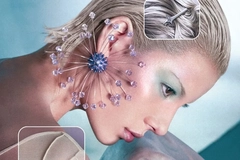Skin care trends: Global market overview
Explore the latest facial skin care trends, including product launches around the world

The demand for skin care solutions that offer convenience, effectiveness, and multifunctional benefits is rising, making self-care a priority in daily routines for consumers with increasingly fast-paced lifestyles. Innova Market Insights highlights the latest facial skin care product launches, including product features, ingredients, and claims. It also reveals future trajectories likely to develop in the global facial skin care market.
Consumers’ skin care preferences and skin care trends
Current skin care trends show that facial skin care remains a top priority, with 58% of consumers globally purchasing products in the past year. It holds the second-highest presence among eight personal care categories, with facial treatments and moisturizers leading in purchases. Women are more likely than men to purchase facial skin care. Younger, high, and mid-high-income consumers are most likely to buy these products.
About half of consumers spend less than 30 minutes per day on their beauty and personal care routine, with little difference between men and women. However, in Brazil, China, and the US, over half spend more than 30 minutes on personal and beauty care.
Skin care trends indicate that sustainability also plays a key role in purchasing decisions, as 51% of consumers prioritize eco-conscious choices, and 45% are willing to pay more for sustainable products. Consumers like to browse online for information on personal care but prefer to buy in-store. One-third define sustainable beauty as preventing damage to the environment, sustainable packaging, and/or natural ingredients.
Facial skin care product launch trends
Global facial skin care launches have experienced a CAGR of 4% over the past five years, slightly behind the 6% CAGR of the overall personal care market, reflecting evolving skin care market trends. The facial and neck toners subcategory leads with a 16% CAGR rise in product launches, followed by cleansers and moisturizers. In contrast, facial treatment launches have been slowing down in the past two years.
Western Europe and Asia are the top regions, accounting for over half of global facial skin care launches in the past two years. The skin care industry is targeting consumers’ on-the-go lifestyles with multifunctional solutions.
The skin care industry is targeting consumers’ on-the-go lifestyles with multifunctional solutions.
Top facial skin care companies, brands, and the skin care industry
The global skin care market shows that the global facial skin care category is somewhat fragmented by manufacturers. L’Oréal, Estée Lauder, Maxingvest, LVMH, Amorepacific, Unilever, L’Occitane, Natura & Co., Shiseido, and Oriflame are leaders in the facial skin care market. These top 10 manufacturers account for 35% of product launches globally in the past five years. Private label accounts for a total of 5% of category launches.
L’Oréal is the top manufacturer in the skin care industry, with 8% of launches during the same period. Some of its top brands are Lancôme, Garnier, CeraVe, Maybelline, La Roche, Yves Saint Laurent, Vichy, Kiehl’s, Nyx, and Skinceuticals. The company’s main growth drivers are its brands, technology, and e-commerce, in tandem with sustainability goals. Its recent introductions include several products in the Lancôme Absolue Rose 80, Garnier Skin Naturals, L’Oréal Paris Revitalift, Wrinkle Expert, and Men Expert lines.
Facial skin care positionings and skin care trends
Facial skin care launches in the skin care industry increasingly highlight anti-aging, brightening, and reducing fine lines/wrinkles claims. Meanwhile, firming, skin disorders, and non-comedogenic claims are also experiencing gradual growth. Many new products make multiple skin health claims, addressing diverse consumer needs.
The global skin care market reveals a rise in normal and combination skin-type positionings for facial skin care launches. While launches for other skin types remain stable, oily skin-type positioning has slowed down in recent years.
In the past two years, 50% of facial skin care products featured free-from claims, driven by no animal ingredients, no animal testing, fragrance-free, and sulfate-free. Ethical positioning gains importance, driven by animal/fish/bird and packaging claims. As demand for transparency and ethical sourcing grows, brands are expanding vegan and natural choices to align with evolving consumer expectations.  Skin care companies are spotlighting environmental sustainability to grab consumer interest.
Skin care companies are spotlighting environmental sustainability to grab consumer interest.
Facial skin care ingredients, packaging and skin care trends
Almost all launches in the skin care industry contain skin conditioning, emollient, emulsifying, humectant, moisturizing, and antioxidant ingredients. Propylene glycol, sodium hyaluronate, caprylyl glycol, vitamin B, and panthenol showed strong growth in launches in the past two years.
In the global skin care market, plastic pump bottles, squeezable tubes, and jars are the top types of inner packaging. Squeezable plastic tube launches display significant growth. Inner packaging varies across product types and regions. A new Hydrating Overnight Mask: Encapsulated Hyaluronic Acid features a plastic tube squeezable format, while Bioaqua Avocado and Bifida Ferment Lysate Moisturizing Essence Mask come in a plastic three- or four-side sealed pouch, highlighting diverse packaging approaches in facial skin care.
What’s next in global facial skin care trends?
Globally, consumers spend less than 30 minutes daily on beauty and personal care. However, based on skin care market trends, more than half of consumers in Brazil, China, and the US spend more than 30 minutes on personal care. Brands can take advantage of the trend toward viewing personal care as an expression of self-care and wellness. By marketing the benefits of using multiple products, brands can turn facial skin care into an enjoyable and relaxing experience.
Sustainability is also a key factor, reflected in skin care trends, with half of consumers prioritizing eco-conscious choices and one-third defining sustainable beauty as environmental protection, sustainable packaging, and natural ingredients. Many companies are already investing heavily in sustainability. Brands should promote their specific sustainable aspects given consumers’ interest. As expectations for ethical and holistic beauty solutions grow, brands that combine sustainability with self-care benefits are likely to lead in facial skin care innovation.
This article is based on the Innova Market Insights report “Now & Next in Facial Skin Care – Global.”












